-
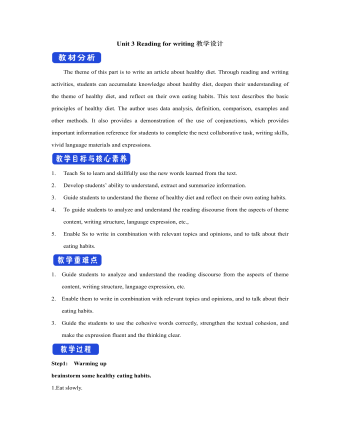
新人教版高中英语选修2Unit 3 Reading for writing教学设计
The theme of this part is to write an article about healthy diet. Through reading and writing activities, students can accumulate knowledge about healthy diet, deepen their understanding of the theme of healthy diet, and reflect on their own eating habits. This text describes the basic principles of healthy diet. The author uses data analysis, definition, comparison, examples and other methods. It also provides a demonstration of the use of conjunctions, which provides important information reference for students to complete the next collaborative task, writing skills, vivid language materials and expressions.1. Teach Ss to learn and skillfully use the new words learned from the text.2. Develop students’ ability to understand, extract and summarize information.3. Guide students to understand the theme of healthy diet and reflect on their own eating habits.4. To guide students to analyze and understand the reading discourse from the aspects of theme content, writing structure, language expression, etc., 5. Enable Ss to write in combination with relevant topics and opinions, and to talk about their eating habits.1. Guide students to analyze and understand the reading discourse from the aspects of theme content, writing structure, language expression, etc.2. Enable them to write in combination with relevant topics and opinions, and to talk about their eating habits.3. Guide the students to use the cohesive words correctly, strengthen the textual cohesion, and make the expression fluent and the thinking clear.Step1: Warming upbrainstorm some healthy eating habits.1.Eat slowly.2.Don’t eat too much fat or sugar.3.Eat healthy food.4.Have a balanced diet.Step2: Read the passage and then sum up the main idea of each paragraph.
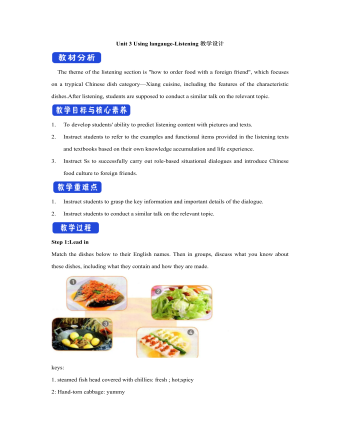
新人教版高中英语选修2Unit 3 Using langauge-Listening教学设计
1. How is Hunan cuisine somewhat different from Sichuan cuisine?The heat in Sichuan cuisine comes from chilies and Sichuan peppercorns. Human cuisine is often hotter and the heat comes from just chilies.2.What are the reasons why Hunan people like spicy food?Because they are a bold people. But many Chinese people think that hot food helps them overcome the effects of rainy or wet weather.3.Why do so many people love steamed fish head covered with chilies?People love it because the meat is quite tender and there are very few small bones.4.Why does Tingting recommend bridge tofu instead of dry pot duck with golden buns?Because bridge tofu has a lighter taste.5 .Why is red braised pork the most famous dish?Because Chairman Mao was from Hunan, and this was his favorite food.Step 5: Instruct students to make a short presentation to the class about your choice. Use the example and useful phrases below to help them.? In groups of three, discuss what types of restaurant you would like to take a foreign visitor to, and why. Then take turns role-playing taking your foreign guest to the restaurant you have chosen. One of you should act as the foreign guest, one as the Chinese host, and one as the waiter or waitress. You may start like this:? EXAMPLE? A: I really love spicy food, so what dish would you recommend?? B: I suggest Mapo tofu.? A: Really ? what's that?
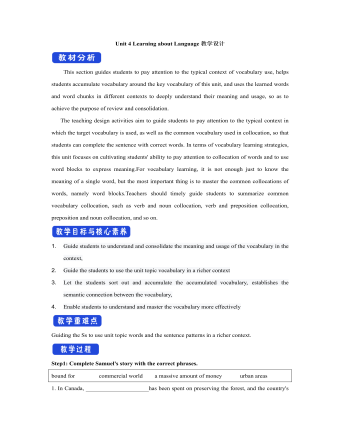
新人教版高中英语选修2Unit 4 Learning about Language教学设计
This section guides students to pay attention to the typical context of vocabulary use, helps students accumulate vocabulary around the key vocabulary of this unit, and uses the learned words and word chunks in different contexts to deeply understand their meaning and usage, so as to achieve the purpose of review and consolidation.The teaching design activities aim to guide students to pay attention to the typical context in which the target vocabulary is used, as well as the common vocabulary used in collocation, so that students can complete the sentence with correct words. In terms of vocabulary learning strategies, this unit focuses on cultivating students' ability to pay attention to collocation of words and to use word blocks to express meaning.For vocabulary learning, it is not enough just to know the meaning of a single word, but the most important thing is to master the common collocations of words, namely word blocks.Teachers should timely guide students to summarize common vocabulary collocation, such as verb and noun collocation, verb and preposition collocation, preposition and noun collocation, and so on.1. Guide students to understand and consolidate the meaning and usage of the vocabulary in the context, 2. Guide the students to use the unit topic vocabulary in a richer context3. Let the students sort out and accumulate the accumulated vocabulary, establishes the semantic connection between the vocabulary,4. Enable students to understand and master the vocabulary more effectivelyGuiding the Ss to use unit topic words and the sentence patterns in a richer context.
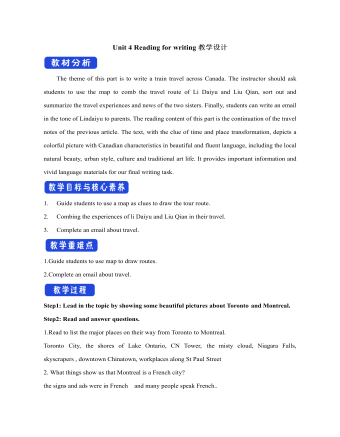
新人教版高中英语选修2Unit 4 Reading for writing教学设计
假定你是英国的Jack,打算来中国旅行,请你给你的中国笔友李华写一封信,要点如下:1.你的旅行计划:北京→泰山→杭州;2.征求建议并询问他是否愿意充当你的导游。注意:1.词数80左右(开头和结尾已给出,不计入总词数);2.可以适当增加细节,以使行文连贯。参考词汇:故宫 the Forbidden City;泰山 Mount TaiDear Li Hua,I'm glad to tell you that 'm going to visit China.First,I am planning to visit Beijing,the capitalof China,where I am looking forward to enjoying the Great Wall,the Forbidden City and somebeautiful parks.Then I intend to go to visit Mount Tai in Shandong Province.I've heard that it is one ofthe most famous mountains in China and I can't wait to enjoy the amazing sunrise there.After that,I amalso going to Hangzhou.It is said that it is a beautiful modern city with breathtaking natural sights,among which the West Lake is a well- known tourist attraction.What do you think of my travel plan? Will you act as my guide? Hope to hear from you soon.

新人教版高中英语选修2Unit 4 Using langauge-Listening教学设计
The theme of the listening section is " talking about scenery and culture along a journey."The part is designed to further lead the students to understand Canadian natural geography and social environment, and integrated into the cultural contrast by mentioning the long train journey from Beijing to Moscow routes. On this basis, the part activates students related travel experience, lets the student serial dialogue, guides the student to explore further the pleasure and meaning of the long journey, and Chinese and foreign cultural comparison.The part also provides a framework for the continuation of the dialogue, which is designed to provide a framework for students to successfully complete their oral expressions, and to incorporate an important trading strategy to end the dialogue naturally.1. Help students to understand and master some common English idioms in the context, and experience the expression effect of English idioms.2. Guide the students to understand the identity of different people in the listening context, and finish the dialogue according to their own experience.3. Instruct the students to use appropriate language to express surprise and curiosity about space and place in the dialogue, and master the oral strategy of ending the dialogue naturally.1. Instruct students to grasp the key information and important details of the dialogue.2. Instruct students to conduct a similar talk on the relevant topic.

新人教版高中英语选修2Unit 5 Learning about Language教学设计
The purpose of this section of vocabulary exercises is to consolidate the key words in the first part of the reading text, let the students write the words according to the English definition, and focus on the detection of the meaning and spelling of the new words. The teaching design includes use English definition to explain words, which is conducive to improving students' interest in vocabulary learning, cultivating their sense of English language and thinking in English, and making students willing to use this method to better grasp the meaning of words, expand their vocabulary, and improve their ability of vocabulary application. Besides, the design offers more context including sentences and short passage for students to practice words flexibly.1. Guide students to understand and consolidate the meaning and usage of the vocabulary in the context, 2. Guide the students to use the unit topic vocabulary in a richer context3. Let the students sort out and accumulate the accumulated vocabulary, establishes the semantic connection between the vocabulary,4. Enable students to understand and master the vocabulary more effectivelyGuiding the Ss to use unit topic words and the sentence patterns in a richer context.Step1: Read the passage about chemical burns and fill in the blanks with the correct forms of the words in the box.
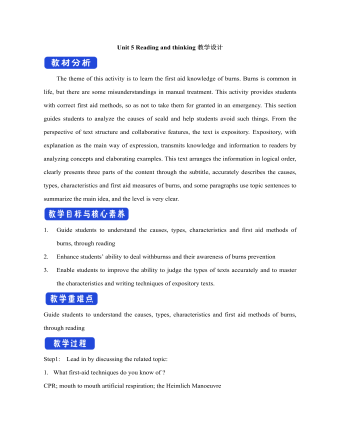
新人教版高中英语选修2Unit 5 Reading and thinking教学设计
The theme of this activity is to learn the first aid knowledge of burns. Burns is common in life, but there are some misunderstandings in manual treatment. This activity provides students with correct first aid methods, so as not to take them for granted in an emergency. This section guides students to analyze the causes of scald and help students avoid such things. From the perspective of text structure and collaborative features, the text is expository. Expository, with explanation as the main way of expression, transmits knowledge and information to readers by analyzing concepts and elaborating examples. This text arranges the information in logical order, clearly presents three parts of the content through the subtitle, accurately describes the causes, types, characteristics and first aid measures of burns, and some paragraphs use topic sentences to summarize the main idea, and the level is very clear.1. Guide students to understand the causes, types, characteristics and first aid methods of burns, through reading2. Enhance students’ ability to deal withburnss and their awareness of burns prevention3. Enable students to improve the ability to judge the types of texts accurately and to master the characteristics and writing techniques of expository texts.Guide students to understand the causes, types, characteristics and first aid methods of burns, through readingStep1: Lead in by discussing the related topic:1. What first-aid techniques do you know of ?CPR; mouth to mouth artificial respiration; the Heimlich Manoeuvre

新人教版高中英语选修2Unit 5 Using langauge-Listening教学设计
The theme of this section is to learn how to make emergency calls. Students should learn how to make emergency calls not only in China, but also in foreign countries in English, so that they can be prepared for future situations outside the home.The emergency telephone number is a vital hotline, which should be the most clear, rapid and effective communication with the acute operator.This section helps students to understand the emergency calls in some countries and the precautions for making emergency calls. Through the study of this section, students can accumulate common expressions and sentence patterns in this context. 1.Help students accumulate emergency telephone numbers in different countries and learn more about first aid2.Guide the students to understand the contents and instructions of the telephone, grasp the characteristics of the emergency telephone and the requirements of the emergency telephone.3.Guide students to understand the first aid instructions of the operators.4.Enable Ss to make simulated emergency calls with their partners in the language they have learned1. Instruct students to grasp the key information and important details of the dialogue.2. Instruct students to conduct a similar talk on the relevant topic.Step1:Look and discuss:Match the pictures below to the medical emergencies, and then discuss the questions in groups.
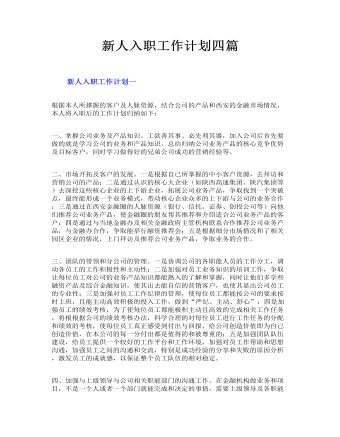
新人入职工作计划四篇
二、市场开拓及客户的发展。一是根据自已所掌握的中小客户资源,去拜访和营销公司的产品;二是通过认识的核心大企业(如陕西高速集团、陕汽集团等)去深挖这些核心企业的上下游企业,拓展公司业务产品,争取找到一个突破点,最终能形成一个业务模式,带动核心企业众多的上下游与公司的业务合作;三是通过在西安金融圈的人脉资源(银行、信托、证券、创投公司等)向他们推荐公司业务产品,使金融圈的朋友帮其推荐和介绍适合公司业务产品的客户;四是通过与当地金融办及相关金融政府主管机构联系合作推荐公司业务产品,与金融办合作,争取能举行融资推荐会;五是根据细分市场情况和了相关园区企业的情况,上门拜访及推荐公司业务产品,争取业务的合作。

人教版高中地理选修3第一章第一节现代旅游教案
香港的旅游特色在“购”,而购物旅游又进一步促进了其他要素的发展。据统计,每年进入香港的国际旅游者中有60%左右的人是为了购物,其购物费用也占全部旅游费用支出的60%左右,使香港这个弹丸之地成为世界的“购物天堂”。思考:1.从旅游六要素的角度看,香港的“购”是如何促进旅游业发展的?点拨:到香港购物是许多游客来港旅游的主要动机。“购”是香港旅游六要素的核心,促进了整个旅游业的发展。2.香港的地理位置和自由港的地位,为旅游业的发展提供了哪些有利条件?点拨:香港是自由港,商品来自世界各地,由于大部分商品不收关税,香港的商品价格就相应较低。此外,这里每年都有许多换季大减价的促销活动,能为游客提供真正的实惠。香港店铺中销售着世界各地不同特色的货品,而且大部分服务行业的从业人员都受过专业训练,态度殷勤友善,以客为先。购物成为香港吸引游客的一个重要因素,为旅游的发展提供了极为有利的条件。

人教版高中地理选修1第一章第一节天体和天体系统教案
【概括】天体是在不断的运动着的。运动着的天体互相吸引和互相绕转,从而形成天体系统。【板书】四、天体系统【启发】天体系统有大有小,大的天体系统又可包含许多小的天体系统。刚才同学们提到的三个天体系统之间是如何包含的呢?(银河系含太阳系,太阳系含地月系)【挂图讲解】地月系只有两个天体,地球和月球,它们之间的平均距离为384401千米;太阳系则包括太阳、九大行星、数十颗卫星及其它天体,整个太阳系的直径至少100亿千米以上;而银河系则拥有2000多亿颗太阳恒星及恒星系统,包括了我 们用肉眼能看到的所有恒星,其主体部分的直径达7万光年,太阳就处于距银河系中心2.3万光年的位置上。【讲解】银河系已如此庞大,是否 就是最大的天体系统呢?是否就是我们的宇宙呢?还远远不是。利用天文望远镜,我们可以观测到在银河系之外,还有约10亿个类似的天体系统,它们被统称为河外星系。
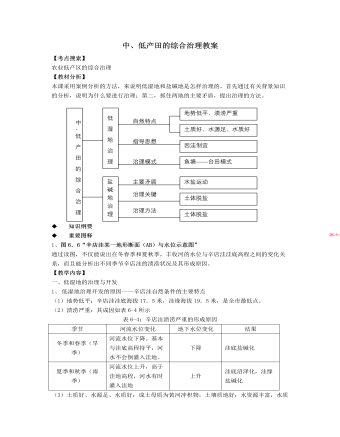
人教版高中地理选修2中、低产田的综合治理教案
一、低湿地的治理与开发1、 低湿地治理开发的原因——辛店洼自然条件的主要特点(1)地势低平:辛店洼洼底海拔17.5米,洼缘海拔19.5米,是全市最低点。(2)渍涝严重:其成因如表6-4所示(3)土质好、水源足、水质好:成土母质为黄河冲积物,土壤质地好;水资源丰富,水质较好。2、低洼地治理开发的方法:鱼塘——台田模式(或称塘田模式)以往辛店洼曾采用挖沟排水的措施治理低洼地,但治理效果不明显,因为辛店洼的主要矛盾是地势低洼,地下水位高,挖沟排水因地势低,排水困难,地下水位难以下降,故治理效果不明显。20世纪80年代以来,科学工作者在辛店洼地区开始了整治低湿地的研究,他们遵循“因洼制宜”的指导思想,逐步摸索出了低湿地的治理模式:鱼塘—--台田模式
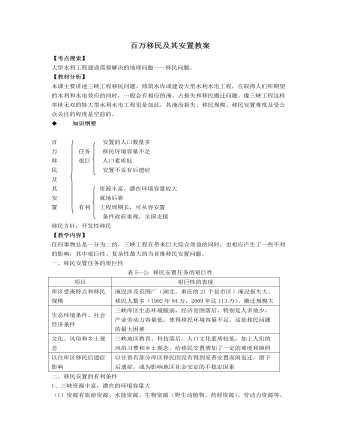
人教版高中地理选修2百万移民及其安置教案
三峡库区农村移民安置根本出路是通过发展大农业来解决耕地不足,不应盲目开垦荒坡地,防止产生新的水土流失,尽量避免生态环境恶化。2、就地后靠,就近安置模式三峡库区淹没区线状分布的受淹特点有别于一般水库淹没区的片状分布,使得库区移民具有相对分散的特点,且淹没涉及的356个乡镇没有一个被全淹,甚至全淹的村也很少,这有利于移民在本县甚至本乡就近后靠安置,避免了水库移民大量外迁、远迁所造成的种种困难和后遗症。三峡移民搬迁大多可以就地后靠,就近安置,这是三峡移民的一大特色。就近后靠安置的优点是不离本乡本土,移民容易接受,且避免了移民大量外迁、远迁所造成的困难和后遗症;缺点是容易对当地的生态环境造成过大的压力,如过度开垦坡地、破坏植被、加剧水土流失等。3、工程周期长,可从容安置移民三峡工程建设周期长(1994年~2009年,共17年),使得移民安置能够及早进行,可以从容安置移民的生产和生活。
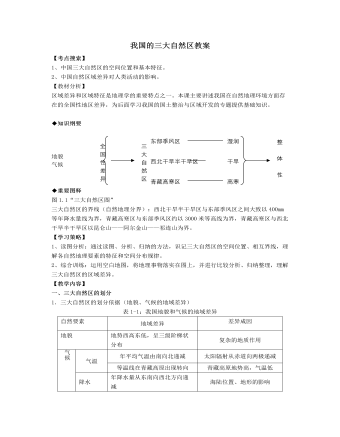
人教版高中地理选修2我国的三大自然区教案
1、中国三大自然区的空间位置和基本特征。2、中国自然区域差异对人类活动的影响。◆重要图释图1.1“三大自然区图”三大自然区的界线(自然地理分界):西北干旱半干旱区与东部季风区之间大致以400mm等年降水量线为界,青藏高寒区与东部季风区约以3000米等高线为界,青藏高寒区与西北干旱半干旱区以昆仑山——阿尔金山——祁连山为界。【学习策略】1、读图分析:通过读图、分析、归纳的方法,识记三大自然区的空间位置、相互界线,理解各自然地理要素的特征和空间分布规律。2、综合训练:运用空白地图,将地理事物落实在图上,并进行比较分析、归纳整理,理解三大自然区的区域差异。【教学内容】一、三大自然区的划分1.三大自然区的划分依据(地貌、气候的地域差异)
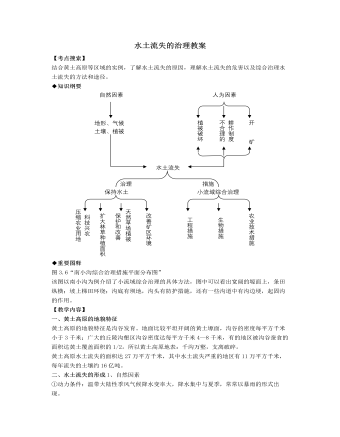
人教版高中地理选修2水土流失的治理教案
2、关于黄土高原小流域及其治理的叙述,正确的是()A.小流域不能看作是一个完整的地域单元B.小流域可以相当于黄土高原上一条河流的整个流域C.小流域综合治理的方针是“保塬、护坡、固沟“D.小流域的综合治理只能采用农业技术措施3、黄土高原植被遭到破坏的原因有()①营造宫殿,毁林开荒②修筑梯田,开石动土③开荒弃荒,轮荒作业④开露天矿,建隔离护坝⑤保塬护坡,打坝建库⑥开挖原生地面,复垦采空矿区A.①②④B.①③⑤C.①③D.②④4、下列关于黄土高原的叙述,正确的是()A.水土流失不可治理B.人为因素是黄土高原现代水土流失的主导因素C.植树种草是做好水土保持的基本前提D.开矿会加剧水土流失,故应少开矿5、引起黄土高原水土流失最直接的因素是()A.降水集中于夏季且多暴雨B.黄土垂直节理发育C.地表崎岖不平,千沟万壑D.不合理开发造成地表黄土裸露,失去植被保护6、治理黄土高原水土流失的工程措施有()A.植树造林B.平整土地C.修建水库D.深耕改土
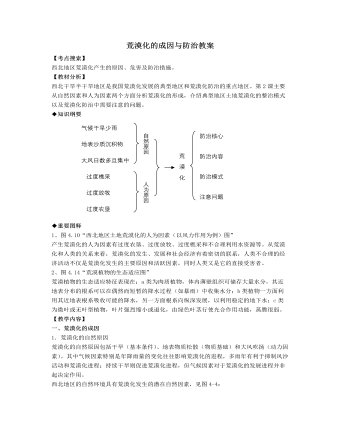
人教版高中地理选修2荒漠化的成因与防治教案
1、图4.10“西北地区土地荒漠化的人为因素(以风力作用为例)图”产生荒漠化的人为因素有过度农垦、过度放牧、过度樵采和不合理利用水资源等。从荒漠化和人类的关系来看,荒漠化的发生、发展和社会经济有着密切的联系,人类不合理的经济活动不仅是荒漠化发生的主要原因和活跃因素,同时人类又是它的直接受害者。2、图4.14“荒漠植物的生态适应图”荒漠植物的生态适应特征表现在:a类为肉质植物,体内薄壁组织可储存大量水分,其近地表分布的根系可以在偶然而短暂的降水过程(如暴雨)中收集水分;b类植物一方面利用其近地表根系吸收可能的降水,另一方面根系向纵深发展,以利用稳定的地下水;c类为微叶或无叶型植物,叶片强烈缩小或退化,由绿色叶茎行使光合作用功能,蒸腾很弱。【教学内容】一、荒漠化的成因1.荒漠化的自然原因荒漠化的自然原因包括干旱(基本条件)、地表物质松散(物质基础)和大风吹扬(动力因素)。
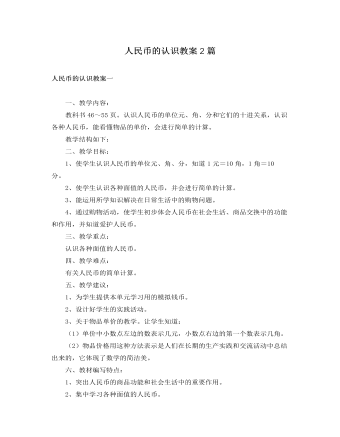
人教版新课标小学数学一年级下册人民币的认识教案2篇
出示例6挂图。教师试问:谁知道0.50元是几角?2.00元是几角?你是怎么知道?以元为单位小数点左边是几就是几元,右边第一位是几就是几角,右边第二位是几就是几分。1.20元是1元2角。35.90元是35元9角。(这部分知识学生知道它表示几元几角就可以了,至于1.20元是个什么数,怎么读、写不需要学生掌握)3、教学例7。(1) 课件演示例7第一小题。教师:0.5元是几角?(5角)0.80元是几角?(8角)学生回答。5角+8角是几角?(5角+8角=13角教师板书)教师问:多少角是1元?13角里面拿出10角还剩多少角?(3角)所以13角等于1元3角。教师板书:5角+8角=13角=1元3角。(2)例7第二小题(课件演示,提出问题:我买这两个气球要多少钱)学生尝试完成,然后提问:你是怎么想的?教师强调:元、角计算,只有在相同单位的情况下,才能相加。
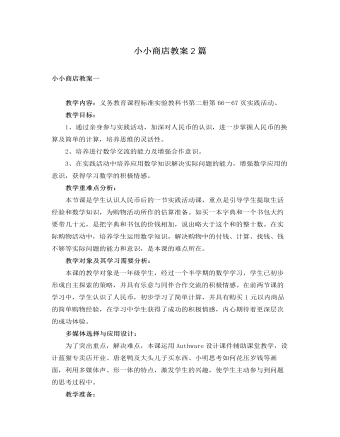
人教版新课标小学数学一年级下册小小商店教案2篇
3、同学们,你们看今天老师带来了什么?(出示一个学生喜欢的玩具)这是昨天老师去商店时买的,猜猜看,这个需要多少钱?(学生猜,教师可提示,最后得出正确标价)今天我们也来开个小小商店玩一玩买卖商品的游戏,想玩吗?4、选营业员及经理。我觉得当营业员最重要的是精通业务,计算能力强。谁想来当?(等学生举手后,教师选出4人。)考虑到我们呆会儿买的人会比较多,每个柜台一个营业员忙不过来,我还准备再选4名商店经理,做好以下几项工作:1)做好接待服务工作,顾客有困难能主动帮助。2)做好买卖过程中的组织工作,让大家有秩序地买商品。3)当营业员计算碰到困难时,两人能商量着解决。觉得自己能做到以上三点的同学可举手参加竞选。(学生举手后,选出4名经理)
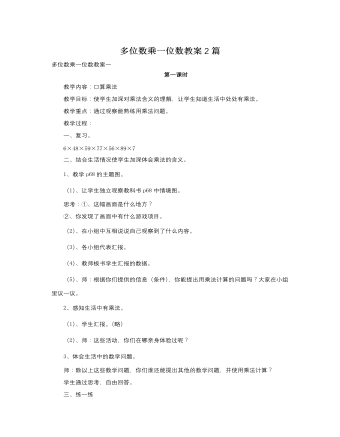
人教版新课标小学数学三年级上册多位数乘一位数教案2篇
教学内容:口算乘法教学目标:使学生加深对乘法含义的理解,让学生知道生活中处处有乘法。教学重点:通过观察能熟练用乘法问题。教学过程:一、复习。6×48×59×77×56×89×7二、结合生活情况使学生加深体会乘法的含义。1、教学p68的主题图。(1)、让学生独立观察教科书p68中情境图。思考:①、这幅画面是什么地方?②、你发现了画面中有什么游戏项目。(2)、在小组中互相说说自己观察到了什么内容。(3)、各小组代表汇报。(4)、教师板书学生汇报的数据。(5)、师:根据你们提供的信息(条件),你能提出用乘法计算的问题吗?大家在小组里议一议。2、感知生活中有乘法。(1)、学生汇报。(略)(2)、师:这些活动,你们在哪亲身体验过呢?3、体会生活中的数学问题。师:除以上这些数学问题,你们谁还能提出其他的数学问题,并使用乘法计算?学生通过思考,自由回答。
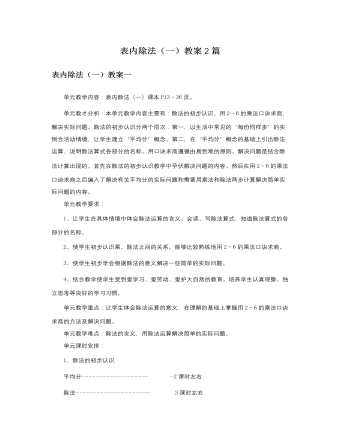
人教版新课标小学数学二年级下册表内除法(一)教案2篇
教后反思本节课给学生创设了良好的活动空间,把学生实际生活中听说过的见到的平均分现象展示给学生看,把生活和数学联系起来,在学生感受“同样多”的基础上概括出什么叫平均分。揭示平均分这一数学知识在生活中的应用,之后突出了学生三次实际操作。第一次,小组同学互相分水果,重视学生分的结果。体会感受“平均分”的含义。第二次,重视分法:15个橘子平均分成5份。体现了学生对物品的不同分法,建立了平均分的概念。第三次,分矿泉水,通过份数变化,观察分的就结果,深刻体会“平均分”,为认识除法积累丰富的知识。为学生营造探索的空间。第二课时:平均分的认识(二)教学内容巩固“平均分”。课本第15页的例题3。教学目标1.巩固“平均分”的概念,知道平均分就是每一份分得结果同样多。

